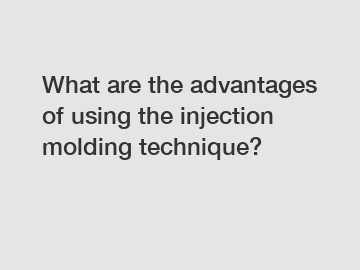What are the advantages of using the injection molding technique?
In today's fast-paced manufacturing world, companies strive to find reliable and efficient techniques that can transform their creative visions into tangible products. Injection molding, a widely recognized manufacturing technique, has emerged as a frontrunner in this regard. With its ability to produce complex and detailed components quickly, injection molding has earned a reputation as a versatile manufacturing solution. In this blog post, we will explore the myriad of advantages that make injection molding the go-to choice for many industries.
Precision and Complexity Refined.
One of the greatest advantages of injection molding is its ability to create intricate and precise components with remarkable consistency. The injection molding process offers manufacturers the freedom to produce complex parts with consistent quality at high volumes. The advanced machinery and expertise involved ensure superior design fidelity and dimensional accuracy, which in turn leads to reduced production flaws and overall improvement in quality control.

Materials Versatility.
Injection molding affords manufacturers the flexibility to work with a wide range of thermoplastic and thermosetting materials. From common polymers like ABS, polystyrene, and polypropylene to more advanced and durable materials such as polycarbonate and nylon, injection molding can handle them all. The ability to choose from a vast array of materials helps cater to diverse industry needs and ensures the perfect material is selected for each specific part.
Cost-Effective Mass Production.
By using injection molding technology, manufacturers can enjoy substantial cost savings when producing large volumes of parts. The automated nature of the process allows for faster production cycles, minimizing labor costs. Additionally, the high level of repeatability and accuracy reduces material waste, boosting overall efficiency and cost-effectiveness. This, coupled with the ability to produce multiple components in a single mold, significantly lowers manufacturing costs, making injection molding an attractive option for high-volume production runs.
Quick Turnaround Times.
In today's fast-paced market, quick turnaround times are often crucial to maintaining a competitive edge. Injection molding delivers on this aspect. The process itself is relatively fast, allowing manufacturers to produce a large number of parts in a shorter time span compared to traditional manufacturing methods. Moreover, the widespread adoption of advanced technologies, such as computer-aided design (CAD) and computer-aided manufacturing (CAM), further optimizes the process for speed, resulting in drastically reduced lead times.
Strength and Durability.
Injection molding produces parts with superb strength and durability. The thermoplastic or thermosetting material is melted, injected into a mold, and then rapidly cooled, resulting in a solid, homogeneous structure that is highly resistant to external impacts and wear. This inherent strength and durability make injection-molded components ideal for applications demanding robustness and longevity, such as automotive, aerospace, and consumer electronics.
Design Freedom and Customization.
Injection molding offers unparalleled design freedom, enabling manufacturers to create intricate shapes, complex geometries, and fine details that may be impossible or prohibitively expensive to achieve with other manufacturing methods. The process allows for precise control over wall thickness, part features, and other critical aspects of component design, making it ideal for customizing products. This advantage is especially valuable in industries that demand personalization, such as medical devices and consumer goods.
Environmentally Friendly Process.
As sustainability becomes an increasingly integral part of businesses worldwide, the injection molding technique holds strong advantages in terms of environmental impact. By minimizing material waste through better control of raw material consumption and optimizing production processes, injection molding significantly reduces the carbon footprint associated with manufacturing. In addition, the recyclability of most thermoplastic materials used in injection molding further contributes to its eco-friendly credentials.
Conclusion.
The advantages of using injection molding as a manufacturing technique are undeniable. Whether it's precision, versatility, cost-effectiveness, or rapid production, this process brings a range of benefits to the table. With its ability to tackle complex designs, produce durable parts, and offer customization options, injection molding has carved itself a niche across numerous industries. As technology and materials continue to advance, injection molding is likely to remain a pivotal technique for manufacturers looking to push the boundaries of innovation and deliver top-quality products to the market.
The company is the world’s best low volume manufacturing china, rapid tooling china, automotive parts rapid tooling supplier. We are your one-stop shop for all needs. Our staff are highly-specialized and will help you find the product you need.


